Motorcycles Are Learning to Save You From Your Own Recklessness
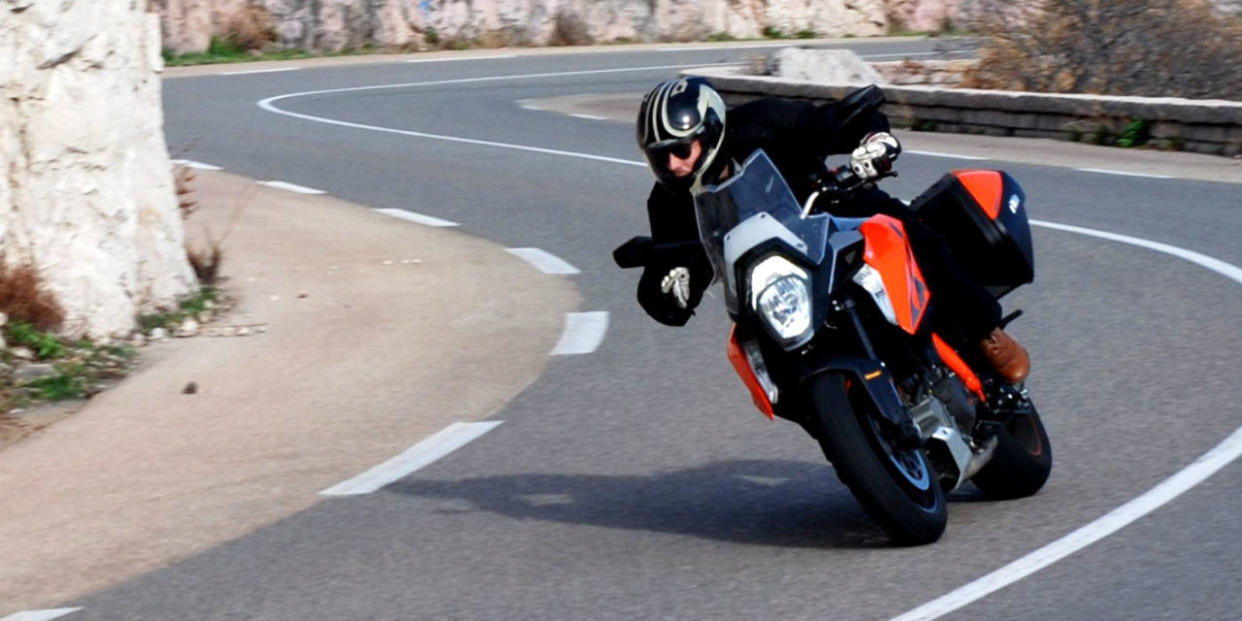
A decade ago, rider skill was the last word in motorcycle performance. Until then, the dream for many riders was that in some far-off future, with enough practice, you might just be able to master your motorcycle. In the dream, you'd slide sideways into corners and spin up the rear tire on the way out, pull big wheelies at will, then haul it up safely in the worst of conditions.
The vast majority of riders never achieved this level of mastery-the job has instead been completed by PhDs around the globe who have been working feverishly to ease the rider's workload. Their efforts have made the bikes themselves so capable that all riders will forever be playing catch-up-and none will ever succeed.
Even if computers haven't quite "solved" motorcycling the way they've "solved" chess-and, more recently, the ancient Chinese strategy board game Go-the most advanced riding aids can now interpret a rider's throttle and brake inputs and then dispatch more appropriate outputs with a level of precision and accuracy that even the world's most skilled riders cannot hope to match.
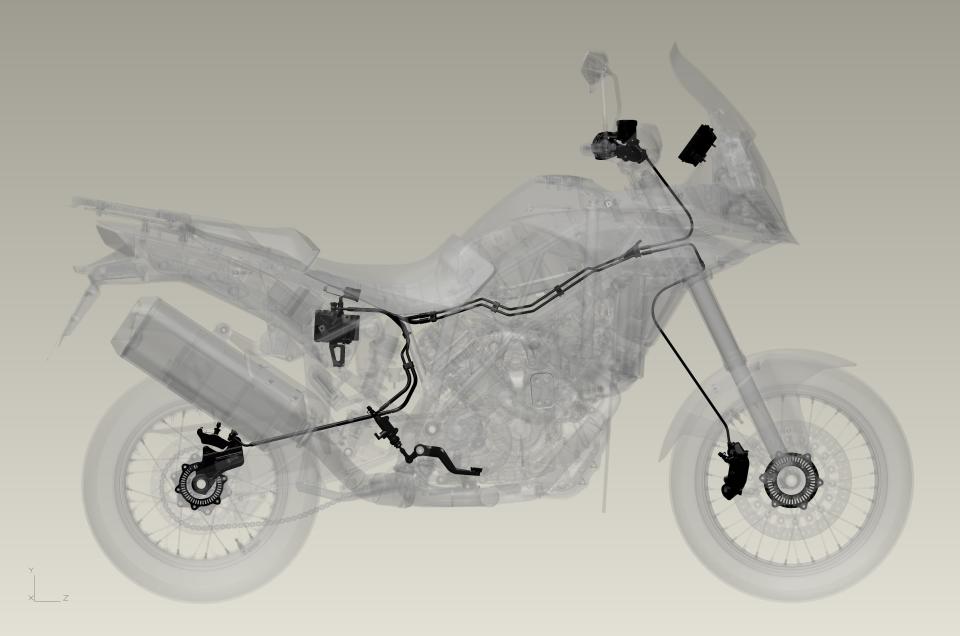
At first glance, it might seem that these technological advances could demoralize a rider-or a board game player-who wants to polish his skills. He's no longer measuring himself against human, fallible giants like MotoGP champion Valentino Rossi, chess grandmaster Garry Kasparov, or Go world champion Lee Sedol. His ultimate match is now against the unbeatable Bosch Motorcycle Stability Control (MSC) and its Inertial Measurement Unit (IMU) (or in the case of games, Deep Blue and AlphaGo).
The Bosch MSC system runs behind the scenes of the top Ducatis, BMWs, and KTMs, and it uses a 6-axis accelerometer-the IMU-as well as suspension sensors to infer the instantaneous dynamic state of the motorcycle and send that information to a group of advanced safety systems. Thus informed, the rapid-pulsing ABS can brake at the limit, redistributing braking force between the front and rear wheels to help keep the motorcycle on track, even in mid-corner. Traction control minimizes rear-wheel slippage to ease rider workload and improve acceleration.
Anti-wheelie systems on older bikes worked by comparing front and rear wheel speeds-as soon as the rear wheel went faster than the front, the computer cut power. By interpreting the accelerometer's data, however, Bosch's system can deduce the bike's pitch, and allows the front wheel to rise into the air without cutting power to the engine. The Super Duke GT also have semi-active suspension that can change damping settings thousands of times during a ride.
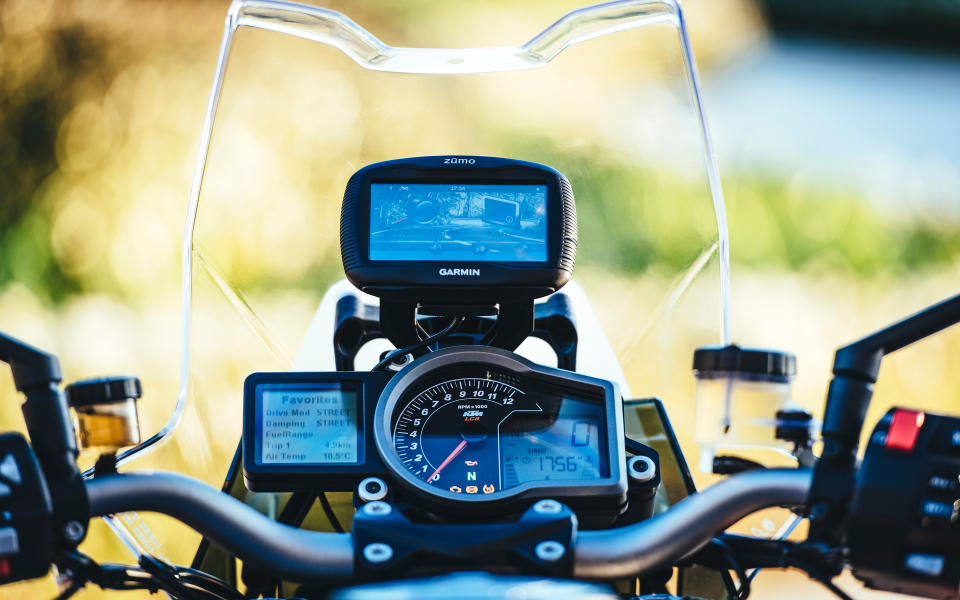
After a few highway miles aboard KTM's 180 bhp, IMU-equipped Super Duke GT, it's easy to wonder what all the fuss is about. It's blindingly fast, but not faster than many conventional superbikes built in the last twenty years. In fact, during normal riding there's only one clue that there's a powerful gyroscopic brain lurking inside: when you lean into a bend at night, a bank of cornering lights turns on to light up the inside of the corner. If you don't push the bike's limits, you'll never get a whiff of the IMU's brilliance.
Fire the Super Duke GT down a mountain road, however, and prepare to recalibrate your idea of what a motorcycle can be.
The combination of the ABS and IMU systems can so effectively evaluate the interface between the tires and the road that the bike frees up the mental effort you had dedicated to assessing-or rather estimating-available traction. Instead of concentrating on the whole picture-deer, crests, slight changes in camber, etc.-you find yourself riding faster than ever before, and yet you remain mentally fresh when you finally stop.
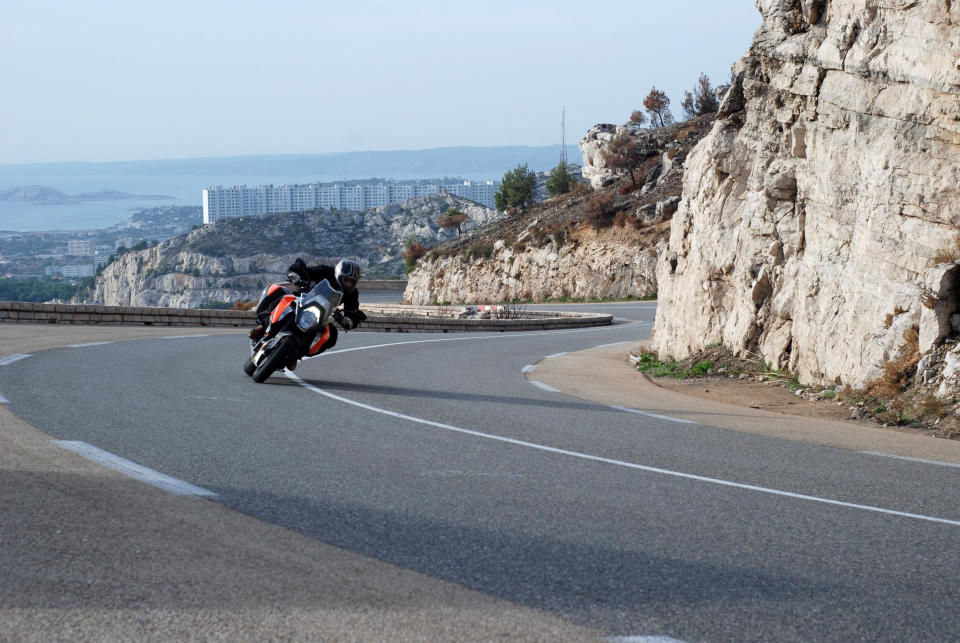
However, to experience the magic of the IMU, your riding style must change. You must trust the computer. Leave the throttle wide open and the front wheel will lift over every crest, but the anti-wheelie will bring it back down again-sometimes many times on one straight. Your job becomes to avoid sand and diesel spills, and avoid coming into corners way too hot. Do that, and the bike will take care of any lingering worry you had about your ability to perform a mid-corner panic stop if you find yourself faced with an unanticipated obstacle. The IMU and ABS units are always waiting in the wings, waiting to take over and finesse the brakes at a moment's notice.
At night, in the wet, the systems are even more impressive-and easier to exploit. On a motorcycle, both tire's contact patches provide a constantly varying amount of grip as they cross over paint stripes and manhole covers, or are weighted and unweighted during acceleration and braking. On a conventional bike, the rider must avoid demanding more from the brakes or throttle than the available grip can provide-otherwise the tires will slide. On the KTM, the systems provide the rider with the option to keep each contact patch at the limit, effectively using the maximum available grip at all points during a maneuver. The effect is to reveal shocking amounts of available grip, even when there are a few slippery portions of road.
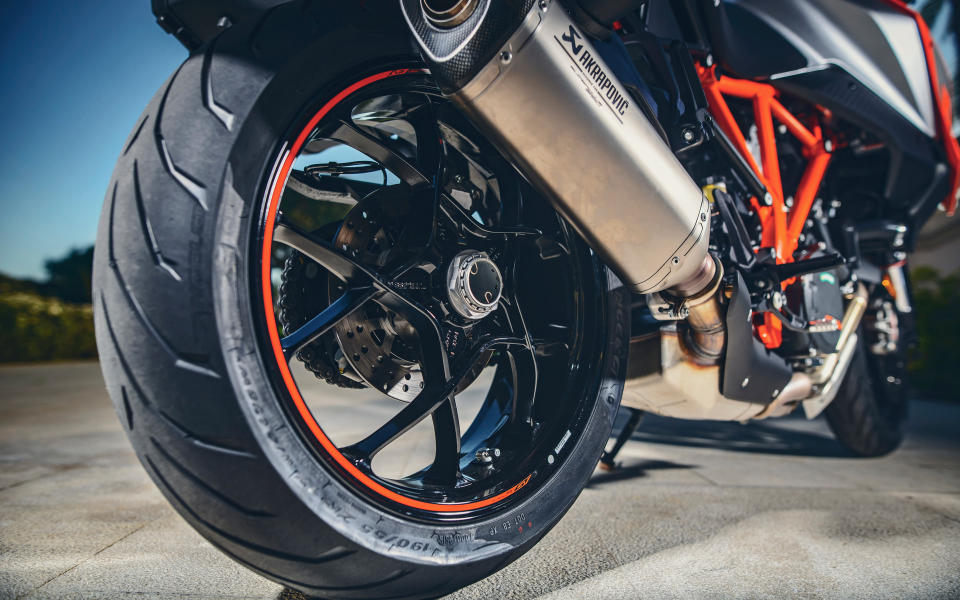
There is no longer a need to warm up mentally, or even to warm up the tires. All you have to do is keep the contact patches off zero-grip surfaces. The sketchiest part of my alpine blast was when I crossed a patch of gravel on the inside of a corner that had recently been resurfaced. The wheels slid sideways. Today's electronics packages, impressive as they are, cannot handle this situation, However, Fevzi Yildirim-head of Bosch's motorcycle safety group-dreams of a day when gyroscopes or outriggers or air blasts could deal with this type of loss of traction.
The KTM's various electronic-aid packages can be turned off individually, but after you change the settings, you have to retune yourself. Without ABS, a panic stop demands more finesse at the levers. Do away with traction control and beware opening the throttle while leaned-over. Oh, and traction control and wheelie control are part of the same package-turn them off, and IMU will no longer intervene to help you tame that rising front wheel.
You're faced with a now-eternal conundrum: are you able to recalibrate yourself well enough to justify the increase in fun against the increased risk of an accident? Reconfigurable electronics lead to second-guessing while riding at the limit-never a good thing.
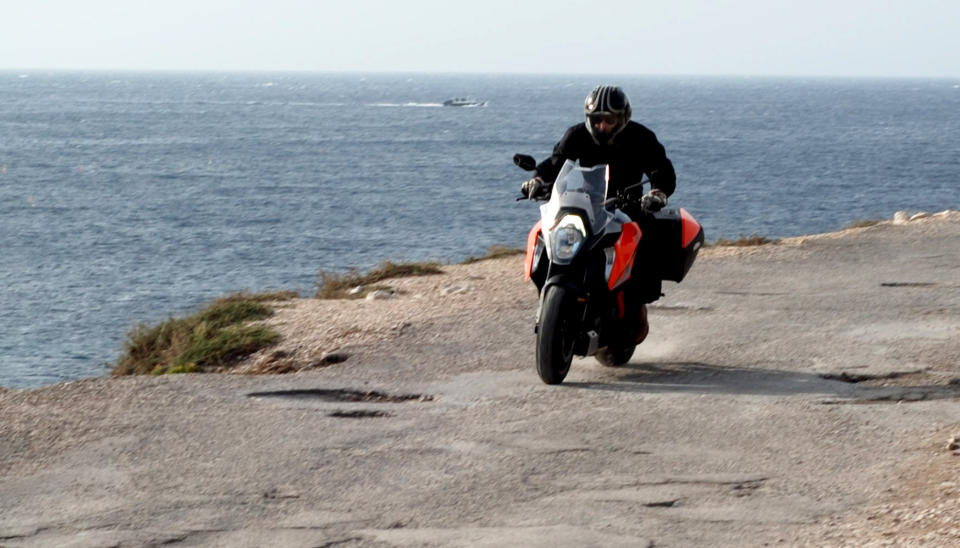
Pushing one of these bikes to the limit is the thrilling intersection between science and sport. More than 100 years of development in tires, brakes, engines, and now electronics work together to put you in danger and simultaneously protect you from it.
There are instances where the electronics find themselves at odds with the spontaneous nature of motorcycle riders. The machine doesn't know in advance when I'm going to want to wheelie for a group of kids, slide into a corner, or do a stoppie when I come up alongside one of my friends at a stoplight. At the same time, I can't know when a deer is going to cross my path mid-corner, or when there will be a bit of sand in a braking zone. Maybe one day, bikes will deduce what electronic aids we want during a given maneuver by interpreting our control inputs. Until then, riders must choose in advance what electronic aids they want.
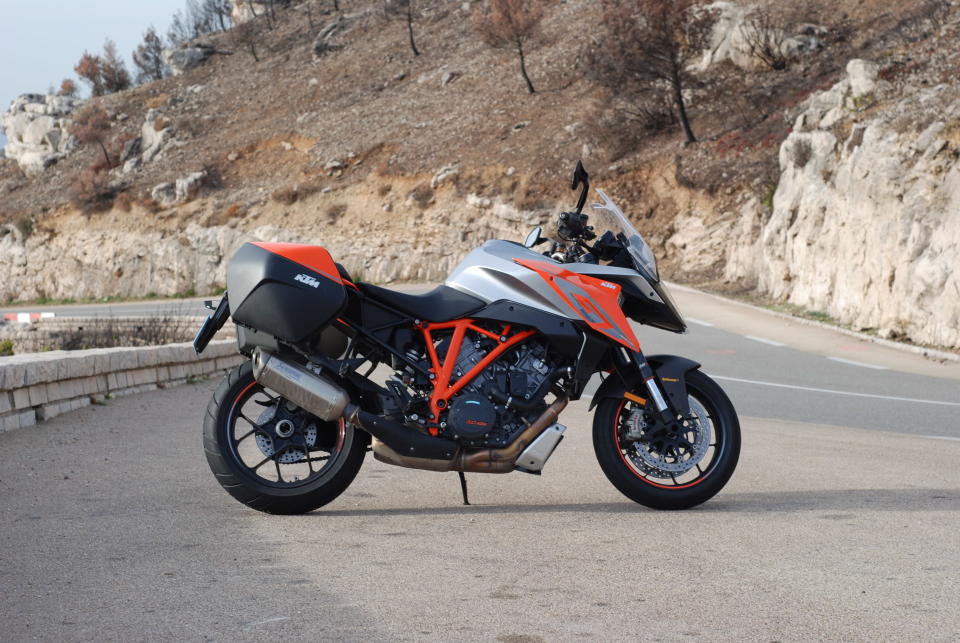
Recent flagship superbikes without IMUs upset the balance between road and machine. They were too powerful to deploy on unpredictable roads-either you were a poseur or a menace. Now, the electronics have enlarged the margin of safety, particularly at high speeds. The meanest bikes and the world's most challenging and enjoyable roads once again find themselves in harmony.
You Might Also Like

